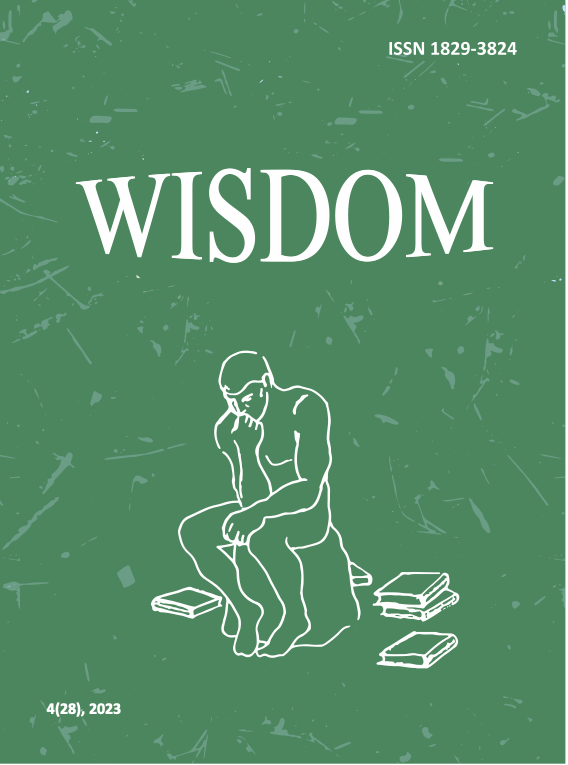Animal Learned Genetic Cognition and the Limits of Anthropomorphic Approach
DOI:
https://doi.org/10.24234/wisdom.v8i1.167Keywords:
instincts, inborn capacities, scheme of an instinct, cognition, learned behavior, elementary cognitive capacities, animals’ learning by imitation, abilities and skillsAbstract
This article discusses the cognitive function of instincts in animal world. The undertaken research demonstrates that the formation of individual’s ability for a certain (complex) action requires having a corresponding specific inborn genetic capacity – the scheme of instinct for that action. Using anthropomorphic approach and the critical verification of its application, authors of this article have revealed the elementary inborn cognitive capacities lying at the basis of the main types of animals’ learned behavior. Special attention is given to the inborn mechanism of animal learning by imitation. The suggested conception of the schemes of instinctive behavior is applied to the analysis of the level of cognitive skills that could be achieved by exercising and training.
Downloads
References
Bates, L. A., & Byrne, R. W. (2010). Imitation: What Animal Imitation Tells Us about Animal Cognition. Wiley, Interdisciplinary Reviews: Cognitive Science 1(5), 685-695.
Birney, R. C., & Teevan, R. C. (Eds.) (1961). Instinct: An Enduring Problem in Psychology. Van Nostrand, Princeton.
Boinski, S. (1988). Use of a club by a wild white-faced capuchin (Cebuscapucinus) to attack a venomous snake (Bothrops asper). American Journal of Primatology, 14, 177–179.
Bouton, M. E. (2007). Learning and Behavior: a Contemporary Synthesis. M.A. Sinauer: Sunderland.
Byrne, R. W. (2005). Social Cognition: Imitation, Imitation, Imitation. Current Biology, 15(13), 498-500.
Byrne, R. W., & Russon, A. E. (1998). Learning by Imitation: a Hierarchical Approach. Behavioral and Brain Sciences, 21(5), 667-684.
Colangelo, N., & Davis, G. (2003). Handbook of Gifted Education. Boston, Pearson education, Inc.
Colvin, G. (2008). Talent is Overrated: What Really Separate World-Class Performers from Everybody Else. New York: Portfolio, Penguin Group.
Dayan, P., Kakade, S., & Montague, P. R. (2000). Learning and selective attention. Nature Neuroscience, 3, 1218–1223.
Djidjian, R. (2004). Getting Ready for Great Discoveries. Yerevan: YSU publication.
Djidjian, R. (2011). Building the Logic of Scientific Discoveries. Problems of Pedagogy and Psychology, 3. Yerevan.
Domjan, M. (2010). Principles of learning and behavior (6th ed). Cengage/ Wadsworth.
Eisely, L. (1961). Darwin's Century: Evolution and the Men who Discovered it. London: Anchor Books.
Fabre, H. (2002). The Hunting Wasps. University Press of the Pacific.
Gagné, F. (2004). Transforming Gifts into Talents: The DMGT as a Developmental Theory. High Ability Studies, 15, 119-147.
Gagne, F. (2015, April-Jun). From Genes to Talent: the DMGT/CMTD Perspective. Revista de Edu-cación, 368, 12-37.
Gladwell, M. (2008). Outliers: The story of Success. New York: Little, Brown & Co.
Goodall, J. (1986). The Chimpanzees of Gombe. Massachusetts: Harvard University Press.
Griffin, D. (1992). Animal Minds. Chicago: The University of Chicago Press.
Groves, P. M., & Thompson, R. F. (1970). Habituation: a Dual-Process Theory. Psychological Review, 77, 419-450.
Harry, J. (2003). Introduction to Logic. New York, NY: Routledge.
Hayes, K. J., & Hayes, C. M. (1952). Imitation in a Home-Raised Chimpanzee. Journal of Comparative and Physiological Psychology, 45(5), 450–459.
Heyes, C. M. (2000). Transformational and Associative Theories of Imitation. MIT Press.
Heyes, C. M., & Ray, E. D. (2000). What is the Significance of Imitation in Animals? In Slater, Peter J.B., Johnsen, S. K., (Eds.). Identifying Gifted Students: A Practical Guide (pp. 215-245). Waco, Texas: Academic Press.
Kaufman, A. B., & Kaufman, J. C. (Eds.) (2015). Animal Creativity and Innovation. Academic Press.
Kaufman, J. C., & Kaufman, A. B. (2004). Applying a Creativity Framework to Animal Cognition. New Ideas in Psychology 22, 143-155.
Kirsch, I., Lynn, S. J., Vigorito, M. & Miller, R. R. (2004). The Role of Cognition in Classical and Operant Conditioning. Journal of Clinical Psychology, 60, 369-392.
Kohler, W. (1927). The Mentality of Apes. London: Routledge & Kegan Paul Limited.
Lorenz, K. (1973a). Behind the Mirror: A Search for a Natural History of Human Knowledge. Mariner.
Lorenz, K. (1973b). Civilized Man's Eight Deadly Sins. Egmont Books.
Lorenz, K. (1979). The Year of the Greylag Goose. Eyre Methuen.
Lorenz, K. (1981). The Foundations of Ethology. Springer.
Lorenz, K. (2002/1949). King Solomon's Ring. Routledge Classics.
Miklósi, A. (1999). The Ethological Analysis of Imitation. Biol. Rev. Camb. Philos. Soc., 74(3), 347-374.
Reader, S. M., & Laland, K. N. (Eds.) (2003). Animal innovations. Oxford: Oxford University Press.
Salmon, M. (2012). Introduction to Logic and Critical Thinking (6th ed.). Wadsworth: Cengage Learning.
Shettleworth, S. J. (2010). Cognition, Evolution, and Behavior (2nd ed.). Oxford University Press.
Sternberg, R. J., & Davidson, J. E. (Eds.) (2005). Conceptions of Giftedness (2nd. ed.). New York: Cambridge UP.
Thorndike, E. (1911). Animal Intelligence; Experimental Studies. McMillan, New York.
Whiten, A. (1998). Imitation of the sequential structure of actions by chimpanzees. Journal of Comparative Psychology, 112(3), 270-281.
Whiten, A., Horner, V., Litchfield, C.A., & Marshall-Pescini, S. (2004). How do Apes Ape? Learning & Behavior. 32(1), 36-52.
Zentall, T. R. (2006). Imitation: definitions, evidence, and mechanisms. Animal Cognition, 9(4), 335-353.
Downloads
Published
How to Cite
Issue
Section
License
Creative Commons Attribution-Non-Commercial (CC BY-NC). CC BY-NC allows users to copy and distribute the article, provided this is not done for commercial purposes. The users may adapt – remix, transform, and build upon the material giving appropriate credit, and providing a link to the license. The full details of the license are available at https://creativecommons.org/licenses/by-nc/4.0/.















